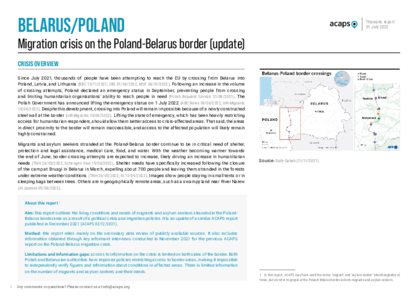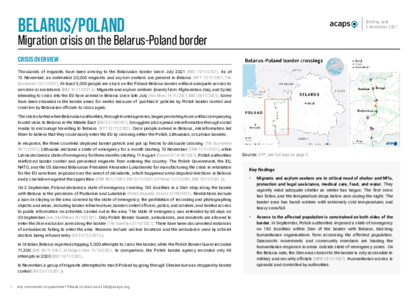Latest updates on country situation
28 November 2023
By the end of November 2023, the number of refugees from Ukraine in Belarus had increased to 37,000 from 22,000 in June. Most refugees came from conflict-affected oblasts, such as the eastern oblasts of Donetsk, Kharkiv, and Luhansk. 80% were displaced in 2022, and the number has continued to gradually increase in 2023. Based on the latest UNHCR survey conducted between April–September, around 35% were staying in rented accommodation, while 40% were with relatives. Cash assistance was reported as the most urgent need and preferred modality of assistance. Healthcare access was unaffordable for 80% of those surveyed. Among the main information gaps are the number of unaccompanied children displaced to Belarus from areas under Russian control in Ukraine and the full extent of the protection risks they are facing. (UNHCR accessed 28/11/2023, UNHCR 10/11/2023, UNHCR 19/06/2023, Conflict Observatory 16/11/2023)
current crises
in
Belarus
BLR002 - Displacement from Russia-Ukraine conflict
Last updated 28/03/2024
Drivers
Displacement
Conflict
Crisis level
Country
Severity level
1.9 Low
Access constraints
3.0
Analysis products
on
Belarus
01 July 2022
Migration crisis on the Poland-Belarus border
DOCUMENT / PDF / 330 KB
This report outlines the living conditions and needs of migrants and asylum seekers stranded in the Poland-Belarus border area as a result of a political crisis and migration policies. It is an update of a similar ACAPS report published in December 2021.
02 December 2021
Migration crisis on the Belarus-Poland border
DOCUMENT / PDF / 610 KB
Thousands of migrants have been arriving to the Belarusian border since July 2021. As at 13 November, an estimated 20,000 migrants and asylum seekers are present in Belarus. At least 5,000 people are stuck on the Poland-Belarus border without adequate access to services or assistance.



